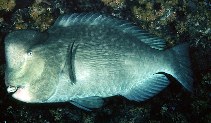| Family: |
Scaridae (Parrotfishes), subfamily: Scarinae |
| Max. size: |
130 cm TL (male/unsexed); max.weight: 46 kg |
| Environment: |
reef-associated; marine; depth range 0 - 40 m |
| Distribution: |
Indo-Pacific: Red Sea and East Africa to Samoa and the Line Islands, north to the Yaeyama and Wake islands, south to the Great Barrier Reef and New Caledonia. |
| Diagnosis: |
Dorsal spines (total): 9-9; Dorsal soft rays (total): 10-10; Anal spines: 3-3; Anal soft rays: 9-9. This species is distinguished by the following characters: median predorsal scales 2-4 (may be obscured by hump); 3 scale rows on cheek, 1 (4-6), 2 (3-6), 3 (1-2); pectoral-fin rays 16 or 17; steep profile distinctive; nodules on teeth unique (Ref. 9793); prominent bump on forehead of adult (evident at least 25 cm TL); deep body 2.0-2.5 in SL, with depth increasing with growth; Colour of juveniles brownish to green with 5 vertical rows of whitish spots on side, the primary phase is a dull gray with scattered white spots, gradually becoming uniformly dark green (Ref. 90102, 1602). |
| Biology: |
Juveniles are found in lagoons while adults inhabit clear outer lagoon and seaward reefs up to depths of at least 30 m (Ref. 9710). They ‘sleep’ in caves and often in shipwrecks at night (Ref. 48636). They are usually in small groups feeding on benthic algae, live corals (Ref. 9710) and shellfishes (Ref. 58784). They sometimes ram their head against corals to facilitate feeding (Ref. 9710). The largest and wariest of the parrotfishes. Assessments showed their vulnerability to overfishing (Ref. 9710). Minimum depth reported taken from Ref. 128797. |
| IUCN Red List Status: |
Vulnerable (VU); Date assessed: 02 March 2007 (A2d) Ref. (130435)
|
| Threat to humans: |
harmless |
Source and more info: www.fishbase.org. For personal, classroom, and other internal use only. Not for publication.
